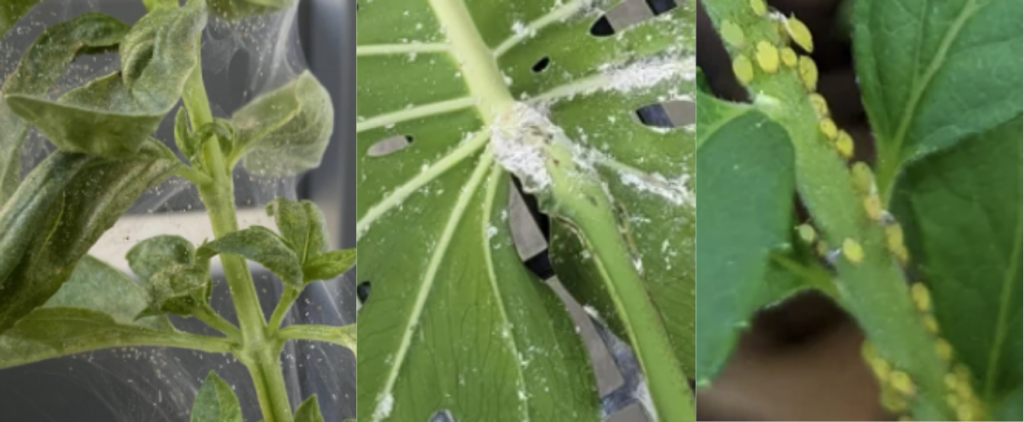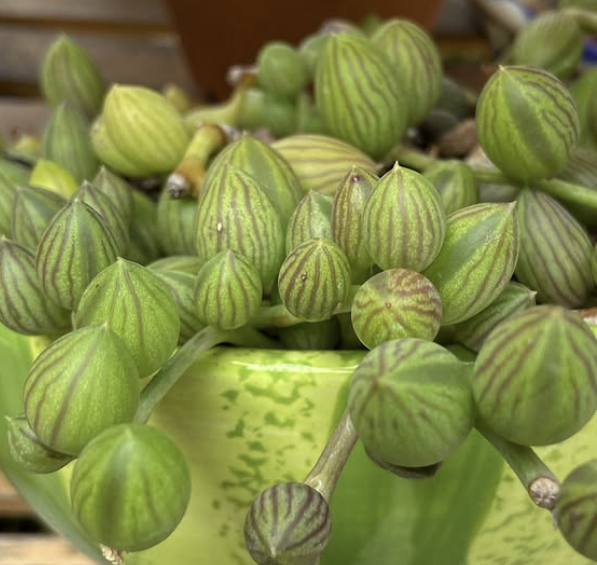The String of Watermelon (Curio herreanus, formerly Senecio herreianus) is a striking, low-maintenance plant that brings a playful charm to any indoor garden.
With its small, round leaves adorned with faint stripes resembling watermelon rinds, this beautiful trailing succulent is an excellent choice for plant lovers of all levels.
Native to South Africa, the String of Watermelon thrives in well-draining soil and a bright location, making it both easy to care for and visually captivating.
Here’s a comprehensive guide to ensure your plant stays healthy and vibrant.
Why Grow a String of Watermelon Plant?
The String of Watermelon is the perfect plant for anyone looking for a low-maintenance plant with character. As part of the Asteraceae family, which also includes daisies, this succulent’s trailing vines and spherical leaves make it a standout. It’s well-suited for hanging pots, high shelves, or as a ground cover in outdoor gardens in warmer climates. With proper care, it can grow quickly, creating a cascade of lush, green foliage that adds life to any space.
How to Identify a String of Watermelon Plant
Also called the String of Watermelons Succulent, this plant is recognized by its egg-shaped leaves with light, horizontal stripes that mimic the appearance of miniature watermelons. The vines are slender stems that can grow several feet long during the growing season. Though similar to the String of Pearls plant, the leaves of the String of Watermelon are more oval and slightly larger, giving it a distinct look.
Size
The String of Watermelon is a compact grower with vines that can trail up to 3 feet in length. The individual spherical leaves are small, typically measuring around 0.5 inches in diameter. While the plant doesn’t take up much space at its base, its trailing nature makes it a dramatic addition to any hanging pot or shelf.
Light Requirements
This plant thrives in bright light and will grow best in a bright spot near a sunny window. While it loves bright sunlight, it’s important to avoid prolonged exposure to intense heat, as the leaves can scorch. If natural light is limited, a grow light can provide the indirect sunlight needed for healthy growth. In areas with partial shade, the plant can survive but may grow more slowly and lose its vibrant green color.
Watering
The String of Watermelon is a succulent plant, so it’s more tolerant of drought than overwatering. You want dry soil before watering, usually every 2–3 weeks during the growing season. During the winter months, reduce watering even further, as the plant enters dormancy. Overwatering can lead to root rot and mushy stems, so always ensure the soil surface feels dry before watering.
Temperature
Native to South Africa, the String of Watermelon prefers warm temperatures between 65–80°F. It can tolerate cooler temperatures, but anything below 50°F may cause damage. If you live in cold climates, keep the plant indoors during the winter or use a heat pack when ordering live plants to protect them from the cold during shipping.
Humidity
This plant does well in low-humidity environments, making it perfect for most homes. However, if you live in an extremely dry climate, you may notice some shriveling in the leaves. Placing the plant near other house plants or lightly misting it occasionally can help maintain a healthy humid environment.
Soil
For a String of Watermelon, a well-draining soil mix is critical. A succulent soil or sandy soil works best, as it allows excess water to drain away quickly, preventing waterlogged roots. If you’re mixing your own soil, combine cactus mix with part perlite for great drainage. Avoid heavy or clay-based soils, as these can lead to rot.
Fertilizer
During the growing season (spring and summer), feed your plant monthly with a water-soluble fertilizer diluted to half strength. Use a balanced liquid fertilizer to promote healthy growth and new vines. Avoid over-fertilizing, as succulents require fewer nutrients than other plants. Stop feeding during the winter months when the plant is dormant.
Potting
Choose a pot with drainage holes to prevent water from pooling at the bottom. While ceramic pots and clay pots can add a decorative touch, ensure they allow good drainage. The String of Watermelon thrives when slightly root-bound, so there’s no need to move it into larger pots frequently. Repot every 2–3 years to refresh the soil and check for signs of root damage.
Pruning
Pruning is an important part of your plant’s care routine. Remove any dead stems or leaves to keep the plant healthy and tidy. To encourage fuller growth, trim back overly long vines. Use clean, sharp scissors and cut just above a leaf node to stimulate new growth.
Propagation
The String of Watermelon is easy to propagate using stem cuttings. Here’s how:
- Select a healthy vine and cut a section 4–6 inches long.
- Allow the cut end to dry for a day to prevent rot.
- Place the cutting in succulent soil or water, ensuring the base of the plant is in contact with moisture.
- Keep the soil slightly damp until roots develop, then switch to a normal watering schedule.
Pests
Though low-maintenance, this plant is occasionally affected by pests.
- Spider mites: Look for fine webbing on the leaves. Treat with neem oil or insecticidal soap.
- Mealybugs: These white, cotton-like pests can cluster on stems. Remove them with a cotton swab dipped in alcohol.
- Fungus gnats: Overwatering can attract these pests. Let the soil dry out to deter them.
Regularly checking your plant can help catch infestations early.

Diseases
The most common issues for this plant are related to watering:
- Root rot: Caused by too much water or poor drainage. Ensure you use well-drained soil and allow the top inch of soil to dry before watering.
- Leaf spot: Fungal diseases may occur in overly wet conditions. Ensure good air circulation and avoid letting water sit on the leaves.
Common Problems
- Squishy beads: Overwatering can cause the plant’s leaves to become mushy and fall off. Adjust your watering schedule to prevent this.
- Yellowing leaves: This is often a sign of overwatering or poor drainage.
- Shriveling leaves: If the round leaves appear wrinkled or shriveled, the plant may need water.
- Slow growth: A lack of bright sunlight or poor care conditions can stunt the plant’s growth.
- Dead stems: Prune these away to prevent fungal infections and encourage new growth.
Is It Toxic?
The String of Watermelon is considered non-toxic to humans and pets, making it a safe addition to homes with children or curious animals.
Difficulty Level
With its low maintenance needs and forgiving nature, the String of Watermelon is a great plant for beginners. It’s adaptable to various conditions and doesn’t require constant attention, making it a favorite among plant parents.
Similar Curio Plants
If you love the String of Watermelon, you might also enjoy other Curio plants:
- String of Pearls plants: Known for their bead-like leaves.
- String of Bananas: A cascading plant with banana-shaped leaves.
- String of Raindrops: Smaller, rounded leaves resembling drops of water.
Summing Up
The String of Watermelon (Curio herreanus) is a unique and versatile hanging plant that’s perfect for any indoor space.
With its vibrant vines, proper care is simple—just provide bright light, well-draining soil, and a regular watering schedule.
Whether you’re new to succulents or a seasoned plant parent, this beautiful trailing succulent is sure to thrive and bring joy to your home.
Frequently Asked Questions (FAQ)
1. How often should I water my String of Watermelon?
Water your String of Watermelon every 2–3 weeks during the growing season (spring and summer) and less frequently during the winter months. Allow the soil to dry out completely between waterings to avoid overwatering and root rot.
2. Why are the beads on my plant turning yellow?
Yellowing beads are typically caused by overwatering or poor drainage. Check the soil’s moisture levels, ensure the pot has drainage holes, and adjust your watering schedule as needed.
3. Can I grow a String of Watermelon in low light?
The String of Watermelon prefers bright, indirect light. While it can survive in lower light conditions, it may grow more slowly and lose some of its vibrant green color. For the best results, place it near a sunny window or use a grow light.
4. What kind of soil should I use for my String of Watermelon?
A well-draining succulent or cactus mix is ideal. You can also make your own by combining regular potting soil with sand or perlite for improved drainage. Avoid heavy soils that retain too much moisture.
5. How can I propagate my String of Watermelon?
Propagation is easy using stem cuttings:
- Cut a healthy vine, allow the end to dry for a day, and place it in moist succulent soil or water.
- Keep the soil damp until roots develop, then transition to a regular watering routine.
6. What pests are common with this plant, and how do I treat them?
Common pests include:
- Spider Mites: Look for fine webbing; treat with neem oil or insecticidal soap.
- Mealybugs: Remove them with a cotton swab dipped in alcohol.
- Fungus Gnats: Often a sign of overwatering; let the soil dry out to deter them.
7. Why is my plant’s growth slow?
Slow growth may be due to it not getting enough light, cooler temperatures, or a lack of nutrients. Move your plant to a brighter location and consider fertilizing during the growing season with a diluted, balanced liquid fertilizer.
8. Can I keep this plant outside?
In warm climates, the String of Watermelon can thrive outdoors in a spot with bright, indirect sunlight. However, it is sensitive to cold temperatures, so bring it indoors if the temperature drops below 50°F.
9. Are String of Watermelon plants safe for pets?
Yes, the String of Watermelon is considered non-toxic to both humans and pets, making it a safe option for households with curious animals or children.
10. What should I do if my plant gets root rot?
If you suspect root rot:
- Remove the plant from its pot and check the roots for mushy, blackened sections.
- Trim away any rotting roots with sterile scissors.
- Repot the plant in fresh, well-draining soil and adjust your watering habits to avoid future overwatering
11. Can I Grow a String of Watermelon in Low Humidity?
Yes, the String of Watermelon can thrive in low humidity, as it is a succulent and adapted to dry environments. These plants naturally store water in their leaves, making them well-suited to lower humidity levels common in indoor spaces. However, if your home is extremely dry (like during winter months with central heating), you can mist the plant occasionally or place it near other plants to create a slightly more humid microclimate. Just ensure there’s adequate airflow to prevent fungal diseases, and avoid letting water sit on the leaves for extended periods.
12. Why Are the Beads on My String of Watermelon Squishy?
Squishy leaves or “beads” often indicate overwatering. When the plant’s roots sit in waterlogged soil for too long, they can’t absorb oxygen, becoming mushy and losing their firmness. To address this, check the soil’s moisture level and let it dry out completely before watering again. Ensure your plant is in well-draining soil and that the pot has adequate drainage holes. If root rot has already set in, you may need to trim the damaged roots and repot the plant in fresh soil.

